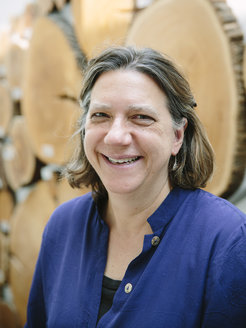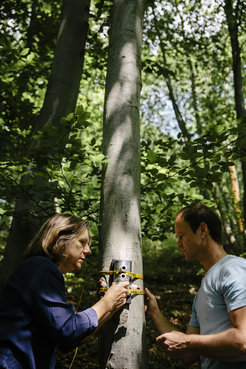“Short-term economic gain brings long-term losses”
Susan Trumbore of the Max Planck Institute for Biogeochemistry on the effect of the forest fires in the Amazon on the global climate
This year, there are almost twice as many fires raging in the Amazon rainforest than there were last year. Many of them were presumably started by humans. The fires burn most easily in areas where the Amazon region is already damaged by extensive deforestation. An interview with Susan Trumbore, Director at the Max Planck Institute for Biogeochemistry in Jena, about the importance of the Amazon rainforest and the threats to this unique ecosystem.

Professor Trumbore, how has the threat to the Amazon changed since Jair Bolsonaro’s government took office?
Before Bolsonaro, there was a growing consensus that economic development in the region could be achieved through more intensive management of already deforested areas without further deforestation. It is sad to see that this consensus has been lost. Bolsonaro argues that developed countries have largely deforested their forests and claims the same right to economic growth for Brazil.
Here is a hopefully hypothetical question: what would happen if the entire Amazon rainforest disappeared?
It’s hard to say for sure. However, a loss of the rainforest would strongly influence the water balance of all of South America because most of the rain circulates through the rainforest there. We would expect increasing droughts and clearly limited possibilities for arable farming. This can already be seen in the arc of deforestation in which large areas have already been deforested. The dry season lasts a month longer there because crops transpire less water and the amount of water in the hydrological cycle decreases. Temperatures would also rise because of reduced transpiration. In recent decades, this has led to an additional local warming that parallels the global warming of the past century.
What changes would there be outside the tropical rainforest?
The rainforest is the heart of the regional climate system. If it disappeared, it would change the path of storms. It would also affect precipitation outside the tropics and shift the desert belts.
The deforestation of the Amazon region caused the disappearance of a huge carbon reservoir. How much CO2 could this release into the atmosphere?
The Amazon rainforest stores up to 150 gigatonnes of carbon in its trees. In the worst case, this could be released if the forest were cleared. For comparison: by burning fossil fuels, humans released about 10 gigatonness of carbon as CO2 in 2018.
You also conduct your own research in the Amazon rainforest. What are the questions in your projects?

We have a joint project with Brazilian partners in Mato Grosso – on the border between the Brazilian savannah and the rainforest. We would like to find out why the border between the two runs exactly there and whether the forest is continuing to give way to the savannah in areas where only small pieces of it are left because of deforestation. We use the long-term experiments on the effects of fires carried out by our partners in order to determine the resistance of these forests to damage.
What did you find out?
The water and energy balances of damaged forests recover quite quickly. This is important for the regional climate. However, we observe that even years later, the forest is still more susceptible to storm damage. And we see grasses migrating into the forest. This makes it easier for fires to spread. There may even be a tipping point at which the forest is so weakened that it becomes a savannah. All in all, the damaged forest still contains significantly less biomass even years later. In other words, it stores less CO2.
Are there other threats to the rainforest besides fires and drought?
As we found out in another project, strong winds combined with heavy thunderstorms, which overturn trees in large areas, can greatly reduce biomass. With climate change, such storms can become heavier and more frequent. As part of this project, we are also investigating how biodiversity is changing in the damaged areas. In the regrowing forest, there are different species than in the intact forest.
You also operate the Amazon Tall Tower Observatory (ATTO). Which questions are you investigating with it?
The ATTO is located in the central Amazon, where there is no long dry season. The forest there was thus less deforested for agricultural purposes. There we can study the energy and water balance of the intact forest and how climate change affects the untouched forest. With the long-term observations we have planned, we would like to test hypotheses about how increasing droughts and storms, which are predicted by climate models, change the regional influence of the forest on the atmosphere. In this way, we hope to identify potential tipping points that would lead to a condition with another type of rainforest – or even without a rainforest – before we reach them.
Based on your investigations, can cleared areas be reforested in such a way that the rainforest can regain its original functions?
That depends on what you want. A depleted forest, perhaps even a plantation, is probably enough for the energy and water balance. But when it comes to biodiversity as well as fruits and other products the forest provides, it is certainly more difficult. Our research so far has shown that many of the trees in the Amazon grow very slowly and that it could take centuries to replace them.
What role do reservations for the indigenous people play in preserving the rainforest?
One of the current problems is that Bolsonaro apparently does not consider it necessary to respect the reserves. The protected areas are not only important for biodiversity but also for the local climate. For example, the Xingu reserve in the South-east is surrounded by largely deforested areas. As my colleagues have shown, the reserve helps to ensure that crops can be grown in other areas. It helps to keep the temperatures a little lower and leads to more rain because of increased humidity.
How can scientists help protect the rainforest?
I think we need to send the message that deforestation beyond a certain threshold can have a massive effect on the local climate, especially rainfall and temperature. For example, short-term economic gain can lead to much greater losses in the long term if the cities are no longer supplied with water or if crop failures occur. The latter has already happened in the Mato Grosso regions in recent years because the dry season lasts longer. Farmers then plant seeds too early and lose their harvest and thus their investment. Perhaps agriculture is no longer possible beyond a certain threshold in deforested areas. All the same: even farmers would like to understand the variability of the regional climate and how it is caused.

